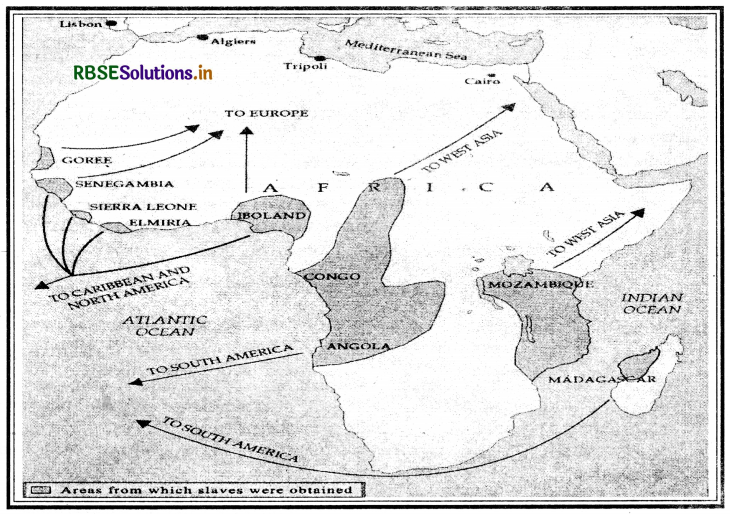RBSE Solutions for Class 11 History Chapter 8 Confrontation of Cultures
Rajasthan Board RBSE Solutions for Class 11 History Chapter 8 Confrontation of Cultures Textbook Exercise Questions and Answers.
Rajasthan Board RBSE Solutions for Class 11 History in Hindi Medium & English Medium are part of RBSE Solutions for Class 11. Students can also read RBSE Class 11 History Important Questions for exam preparation. Students can also go through RBSE Class 11 History Notes to understand and remember the concepts easily.
RBSE Class 11 History Solutions Chapter 8 Confrontation of Cultures
RBSE Class 11 History Confrontation of Cultures Textbook Questions and Answers
Question 1.
Compare the civilisation of the Aztecs with that of the Mesopotamians.
Answer:
|
Aztec Civilisation |
Mesopotamian Civilisation |
|
(i) Aztec society was hierarchical. |
(i) Mesopotomian society was divided into three classes. |
|
(ii) People worshipped the gods of war and the sun. |
(ii) People worshipped many gods and goddesses. |
|
(iii) Canal irrigation was done. |
(iii) It was a river valley civilisation hence canals were also there for irrigation. |

Question 2.
What were the new developments helping European navigation in the 15th century ?
Answer:
(i) In 1380, Magnetic Compass was invented. It helped in searching and identify four cardinal directions.
(ii) Development also took places in the manufacturing of sailing ships.
(iii) Ptolemy’s geographical information helped the sailors in about different cardinal directions.
(iv) Written accounts of great personalities like Morco Polo helped in creating wide interest among the people.
Question 3.
Give reasons for Spain and Portugal being the first in the 15th century to venture across the Atlantic.
Answer:
Spain and Portugal ventured across the Atlantic first because of following reasons :
(i) Rulers of both Spain and Portugal had passion for acquiring immence wealth in the form of gold and treasure for glory and titles.
(ii) They were eager to spread Christianity on other lands. So they were ready for any adventure.
(iii) They also wanted to establish colonies.

Question 4.
What new food items were transmitted from South America to the rest of the world ?
Answer:
(i) Potatoes,
(ii) Canesugar,
(iii) Cacao,
(iv) Chillies.
Answer in Short Essay :
Question 5.
Write an account of the journey of an African boy of seventeen captured and taken to Brazil as a slave.
Answer:
The journey of the African boy was very rigid. He was made slave and departed with other slaves to a ship. Their journey started from Congo. Their ship sailed in the Atlantic Ocean and reach Brazil in South America via Angola.

Question 6.
How did the ‘discovery’ of South America lead to the development of European Colonialism ?
Answer:
1. For Europe, the 'discovery' of the Americas had consequences for other besides the initial voyagers. The influx of gold and silver helped further expansion of international trade and industrialisation. Between 1560 and 1600, a hundred ships each year carried silver from South American mines to Spain.
But is was not Spain and Portugal that benefited. They did not invest their huge income in further trade, or in building up a merchant navy. Instead, it was the countries bordering the Atlantic, particularly England, France, Belgium and Holland, that took advantage of the 'discoveries'.
2. Their merchants formed joint-stock companies and sent out trading expeditions, established colonies and introduced Europeans to the products of the New World, including tobacco, potatoes, cane-sugar, cacao and rubber.
3. Europe also became familier with new crops from America, notably potatoes and chillies. These were then taken by Europeans to other countries like India.

4. For the native people of the Americans, the immediate consequences were the physical decimation of local populations, the destruction of their way of life and their enslavement in mines, plantations and mills.

- RBSE Class 11 History Important Questions Chapter 1 From the Beginning of Time
- RBSE Class 11 History Important Questions Chapter 10 Displacing Indigenous Peoples
- RBSE Class 11 History Important Questions Chapter 2 लेखन कला और शहरी जीवन
- RBSE Class 11 History Important Questions Chapter 7 Changing Cultural Traditions
- RBSE Class 11 History Important Questions Chapter 6 तीन वर्ग
- RBSE Class 11 History Important Questions Chapter 6 The Three Orders
- RBSE Class 11 History Important Questions Chapter 3 तीन महाद्वीपों में फैला हुआ साम्राज्य
- RBSE Class 11 History Important Questions Chapter 3 An Empire Across Three Continents
- RBSE Solutions for Class 11 History Chapter 1 From the Beginning of Time
- RBSE Class 11 History Important Questions Chapter 11 Paths to Modernisation
- RBSE Class 11 History Important Questions in Hindi & English Medium